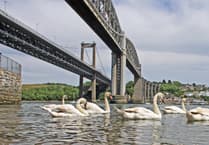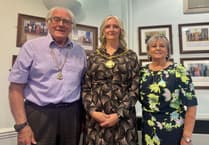Having this week visited Forder for the first time, albeit on a cold wet day, I have come to the conclusion that it is one of South East Cornwall's best kept secrets.
It is a conservation area and designated as a place of outstanding natural beauty, two accolades justified by the myriads of birds, butterflies, moths, wild plants and native mammals who have chosen to make this lovely place their home.
Tucked well out of sight in a deep valley below bustling Burraton in Saltash, it is hard to imagine that this tranquil backwater is so close at hand.
The name Forder comes from the ford which used to be in the village, created by the Latchbrook stream. However, a bridge was eventually built over it, but you can still see the water rushing through, on its way to join the Lynher creek, around which many of the houses are attractively clustered.
Many residents, as well as a few visitors in the know, moor their boats in the creek, but they are mainly for leisure purposes, the days long gone when Forder received the many barges coming up river to load up with stone from the former Castle Park Quarry.
Forder dates further back in history than its larger neighbour Saltash, and from medieval times right up until the 1950s, together with nearby Antony Passage, it has been a centre of industry. These have included flour milling, fulling, water transport, market gardening, lime burning, roadstone quarrying and concrete block making. The houses associated with these activities have now been sensitively renovated into very desirable homes, and this has certainly helped with the overall cared for appearance of the village.
In fact, so keen are the residents to help protect the special nature of Forder, that they have an active Community Conservation Association. It was formed in 1971, and a long-term trustee and active worker has been John Miller, who together with his wife Thelma, moved to the village 35 years ago.
John was responsible for erecting and decorating the first Christmas tree in Forder in 1966, a task which he still carries out each year, and in his bulging folder of community records he has the original receipt for tree and lights of £10 8s 7d. But costing a great deal more will be the association's latest project.
Forder has met socially in the wooden hut on the quay, leased from the Duchy of Cornwall, for about 20 years, but it is now in poor condition so every household has received a questionnaire asking if they would be in favour of supporting the erection of a new building. Grant aiding would be sought in partnership with the hoped-for voluntary labour, fundraising activities and donations.
Excitement
John and Thelma enjoy helping with the events organised by the association, which villagers, young and old enjoy. These include annual events such as the summer fete (July 29), a social (September 9), which is also the time the winner of the sunflower competition is announced, a Hallowe'en party and during the festive season a Christmas carol service when the Mayor of Saltash turns on the tree lights. Father Christmas also arrives with gifts for the children and senior citizens, and when the tide is right, he travels up river by boat, excitement rising at the sound of his jingling bell and the sight of his lamp in the distance. However, more often than not nature is not obliging and he comes by road, so everyone was delighted last year, when Pat Crawford constructed a special motorised sleigh. With funding for a new hall in mind, the association says they would be happy to hire it out to other communities.
For John, the monthly delivery of the association newsletter to over 90 homes is a leisurely walkabout compared to the time when he was an avid trials rider with the Liskeard Motor Cycle Club. A favourite hobby for about 10 years, the glass cabinet in the sitting room is full of silverware, including two gold awards from the Welsh three day trials. One of John and Thelma's three daughters is Donna Miller who with her husband Ken runs Saltash's popular Rodney Inn.
Living in the former Methodist Chapel are Jack and Annette Hulbert who were residing in Langley in Berkshire when they bought it at auction in 1977. For the following three summers they lived in the building as they renovated it before finally moving in. They say that now their daughter Melissa has left home the chapel is really too big for them, but they love it and Forder so much that they have decided they will stay. Jack keeps a 26ft Snap Dragon yacht called Melanack which is an anagram of the couple's first names, and Annette is quite famous locally for her well-known 'Hedgerow Jam' which she used to market in a small way.
The couple are great collectors of old and interesting objects which are on display all over the house and upstairs is their most treasured find which is the original organ belonging to the chapel. Still in working order, they traced it to Richard Chapman of Antony Passage who agreed to part with it. In their hallway hangs a 'Charter of Young Methodism' which was found during the renovations.
The chapel was built in 1846 and enlarged in 1899 to make space for a Sunday school. On this part of the building is still to be seen the names of the local people who donated money for its erection. After being in regular use for 128 years, the chapel finally closed its doors on November 3, 1974, its Bible being taken to Burraton Chapel.
In front of the Hulberts' home is Limekiln Cottage once the home of Kim Kernohan's grandfather, who lived to be nearly 100 years old. Kim, who resides with her husband Mick in one of the pretty cottages known as Riverside, has lived in the village all her life.
Her neighbour is Basil Rogers who moved to Forder in 1958, but has been associated with the village throughout his life, his uncle, Mr Walter Stear, now 90 and a resident at The Elms, Saltash, having owned Wivescombe Farm.
Wellingtons
Basil recalls that when he first lived at Riverside all the residents along that part of the quay virtually lived in their wellingtons because at each high tide the water would come right up to the front doors.
'We could watch the swans sail by and feed them from the doorstep,' he laughs, 'you had to be Neptune to live here then.' However, it was Basil who eventually made the road up about 2ft higher and built the bank, making life a little less waterlogged for everyone.
Now retired from his own haulage company, B J Rogers and Son, he remains in partnership with his son Andrew.
Basil recalls being one of the first Western National drivers to bring buses to Forder.
'There used to be 24 buses a day,' he says, 'even double deckers, but now we are lucky if we see three.'
Along from Riverside lives Colin Brown at 'The Moorings', and on the opposite side of the creek is the Old Mill, the home of Glyn and Trish Gough. These are the two oldest houses in Forder, although one of the best-known is Apple Tree Cot, which until 1900 had a thatched roof. It was the best-known of five tea gardens in the Saltash area, the last proprietor being Hugh Seccombe, uncle of Sir Vernon Seccombe.
There are three councilbuilt bungalows for senior citizens known as Scannell Close, one of the residents there being Mabel Burrows, now in her late-70s. She was born in Antony Passage where her parents ran one of the tea gardens. She moved to Forder upon her marriage to the late Ron Burrows, who she recalls used to court her by swimming across the river from Point Fields. A Londoner he was stationed locally while in the RAF.
There are not many young families in Forder, but Angela and Terry Woodcock, parents of the youngest resident in the village, one-year-old Jack, say it is a wonderful place in which to bring up a family. They moved to their quayside home, where their sailing boat Toggle is moored outside the front door, about eight years ago. They also have two daughters, Emma (seven), a pupil at Sir Robert Geffery School, Landrake, and Amy who is two-and-a-half.
'The children are so lucky,' says Angela. 'When the tide is out they can safely go exploring in the creek where they find crabs under the seaweed, and jelly fish almost on the doorstep.'
Visiting Angela on the day the Cornish Times called was Joanne Legg who lives just above Forder at Trematon. She is expecting her second baby in September, and often pops down to the village to meet up with her friend so daughter Emily, almost three, has someone to play with.
The friends laughingly describe themselves as being members of the 'Mums Club'. They say there are about six of them in the area who meet up in each others' houses so the children can have fun together and they can have a chat.
'It is also a good excuse not to tidy up,' laughs Angela.
Looking down on Forder are the remains of Duchy-owned Trematon Castle, which probably began life as a wooden stockade built by the Saxons. The motte and bailey castle were constructed in about 1070 with further additions down through the centuries. Roger de Valletort sold the castle and barony to Richard, Earl of Cornwall in 1270. The earldom later became extinct but all its possessions, including Trematon Castle passed to the Duchy, which was created by King Edward III in 1337 for his eldest son Edward, who earned the infamous name, 'Black Prince'. He is said to have stayed there.
The only surviving record of hostilities at the castle involves the Prayer Book Rebellion of 1549, when the Cornish, still speaking their own language, rebelled against the abolition of the old Latin mass. Sir Thomas Grenville, his wife and other Protestants took refuge in the castle where they were besieged by some of the rebels.
Fascinating
The village and surrounding area has a rich and fascinating history, which Pam Parsons diligently collated to produce a book entitled 'Forder' in 1997. She arrived from Hull with husband John in 1994, and by 1995 the couple had become active members of the community, and had joined the conservation association of which Pam is now secretary.
She says at a meeting several people had said there were many notes and memories available about Forder and they needed to be properly recorded for visitors and for the many school children who arrive to study the creek and past industries.
'I volunteered to do the job and learned much,' she says. 'We really like it here. The sailing boats, the walk to Antony Passage, it is all so lovely. Most of all we appreciate the community because people get on together and they care for the environment.'
And just to prove Pam's point, tomorrow (Saturday) April 8, the folk of Forder will once again be donning gloves for the annual 'Creek Clean Up' as part of National Spring Clean 2000.



